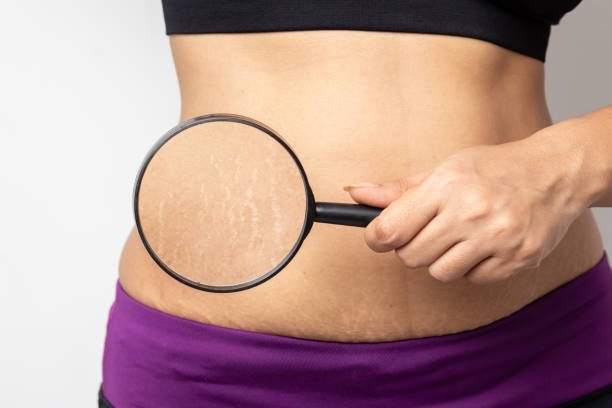Stretch marks are a natural part of many pregnancies. They’re a reminder of a beautiful journey, but if you’re feeling self-conscious about them, you’re not alone. Pregnancy brings many changes and stretch marks can be one of them – narrow, streak-like lines ranging in colour from pink and red to purple and brown. They affect around 8 out of 10 pregnant women, typically appearing on the tummy, upper thighs, or breasts as the baby bump grows.
For some women, the first sign of stretch marks is itchiness, where the skin begins to stretch and thin. Throughout this article, we’ll explore what causes these marks and how a dermatologist-recommended stretch marks cream like Mederma Stretch Marks Therapy can provide targeted care. If you’re looking to support smoother skin, this cream might be the right choice for you.
Understanding Pregnancy Stretch Marks
Stretch marks, or striae gravidarum, are common in pregnancy. They form as the body rapidly expands to make room for a growing baby.
What are the Causes
- Physical Stretching: During pregnancy, the skin stretches as the belly, thighs, and breasts grow. This quick expansion doesn’t allow the skin enough time to adapt, leading to small tears. These tears heal as stretch marks, becoming visible lines on the skin’s surface.
- Hormonal Changes: Elevated hormone levels attract more water into the skin, making collagen bonds softer and more likely to tear. This hormone-driven change primes the skin, which can increase the likelihood of stretch marks forming during pregnancy.
When and Where They Appear
Stretch marks typically appear in the later trimesters (sixth or seventh month), but they can start earlier. For some, stretch marks appear as pinkish streaks; for others, like those with darker skin tones, they may be lighter than the surrounding skin. These marks are most common on areas like the tummy, upper thighs, and breasts—where the skin stretches most as pregnancy progresses.
Risk Factors
Genetics, rapid weight gain, and younger age are significant factors. If family members have stretch marks, you might be more likely to develop them, too. Rapid weight gain during pregnancy and a younger maternal age increases the risk.
Prevention vs. Treatment
Prevention and treatment often go together. If you’re thinking about starting a stretch marks cream, the best time is early in your pregnancy, ideally in the first trimester. Applying a stretch marks cream early on helps your skin stay moisturised and more elastic as it starts to stretch.
- Starting early gives your skin a boost of hydration, which may help reduce the chance of noticeable stretch marks.
- Consistency is important—using stretch marks cream regularly can help your skin feel softer and less prone to tearing.
While stretch mark creams like Mederma Stretch Marks Therapy add needed moisture, it’s good to keep realistic expectations. Remember, stretch marks are common and natural. Creams can support your skin’s healing process, but they work best for softening and smoothing, not total removal.
Dermatologist-Recommended Cream
Mederma Stretch Marks Therapy is crafted to support your skin through life’s natural changes, blending key ingredients that work together to decrease the appearance of stretch marks and make your skin look and feel smooth.
Key Ingredients
- Cepalin™ Magic: A unique onion extracts that calms inflammation and helps in skin repair.
- Hyaluronic Acid Boost: Locks in moisture, keeping skin soft, supple, and hydrated.
- Centella Asiatica Powerhouse: Known to tone and tighten the skin, enhancing elasticity.
Best For
Ideal for anyone wanting a gentle, effective solution for stretch marks. Safe for use during and after pregnancy.
Price Range
Available at ₹595.00 for 25 g and ₹1,045.00 for 50 g.
Dermatologist’s Notes
Mederma is paraben-free, making it safe and gentle on sensitive skin. Recommended by dermatologists and gynaecologists, this stretch marks cream is trusted for its clinically backed results, with a 40% improvement in appearance over 12 weeks.
Pros and Cons
- Pros:
- Contains botanical Cepalin for visible results
- Clinically proven to improve colour and texture
- Hydrates deeply, promoting skin elasticity
- Safe for pregnancy and breastfeeding
- Cons:
- Requires consistent application for best results
- It may take time to see visible improvements
How to Use Mederma Stretch Marks Therapy
For the best results, add Mederma Stretch Marks Therapy to your daily routine. Here’s a step-by-step guide:
- Cleanse and Dry: Start with clean, dry skin.
- Gentle Massage: Apply a thin layer of the stretch marks cream to the stretch mark area twice daily, in the morning and evening. Use circular motions to improve absorption and encourage skin renewal.
- Stay Consistent: Consistent use is crucial. Results may start appearing within four weeks, but most see optimal improvements after 12 weeks of regular application.
Application Tips
- For larger areas like the stomach or thighs, massage gently for better absorption.
- Always avoid contact with the eyes and use externally only.
Additional Notes
- Patch Test: Try a small patch on your forearm to ensure no sensitivity.
- Store in a cool, dry place and keep away from children.
Additional Prevention Tips
In addition to using stretch marks cream, there are simple lifestyle habits that can help your skin stay resilient and reduce the chance of developing stretch marks.
- Hydration: Drinking water keeps your skin hydrated, which makes it more elastic and less prone to tearing as it stretches.
- Nutrition: A balanced diet rich in vitamins C and E, zinc, and protein supports collagen production, which is important for maintaining skin strength and elasticity.
- Exercise: Regular, moderate exercise boosts circulation, delivering oxygen and nutrients to your skin, which aids in skin repair and resilience.
- Other Skincare Habits: Moisturising your skin daily with a gentle lotion can further enhance skin elasticity. Avoid harsh soaps that take away natural oils, as well as long, hot showers that can dry out the skin.
Feel Confident in Your Skin’s Journey
Stretch marks are a normal part of life’s changes. If you’re looking to soften their appearance, Mederma Stretch Marks Therapy offers a gentle, dermatologist-recommended solution that supports your skin’s resilience.
With regular use, Mederma’s hydrating formula can help make stretch marks less visible over time. Just apply the stretch marks cream consistently and be patient—you may soon notice a difference in your skin’s texture and appearance. Consider stretch marks cream as part of your daily routine. Your skin deserves care and comfort.























